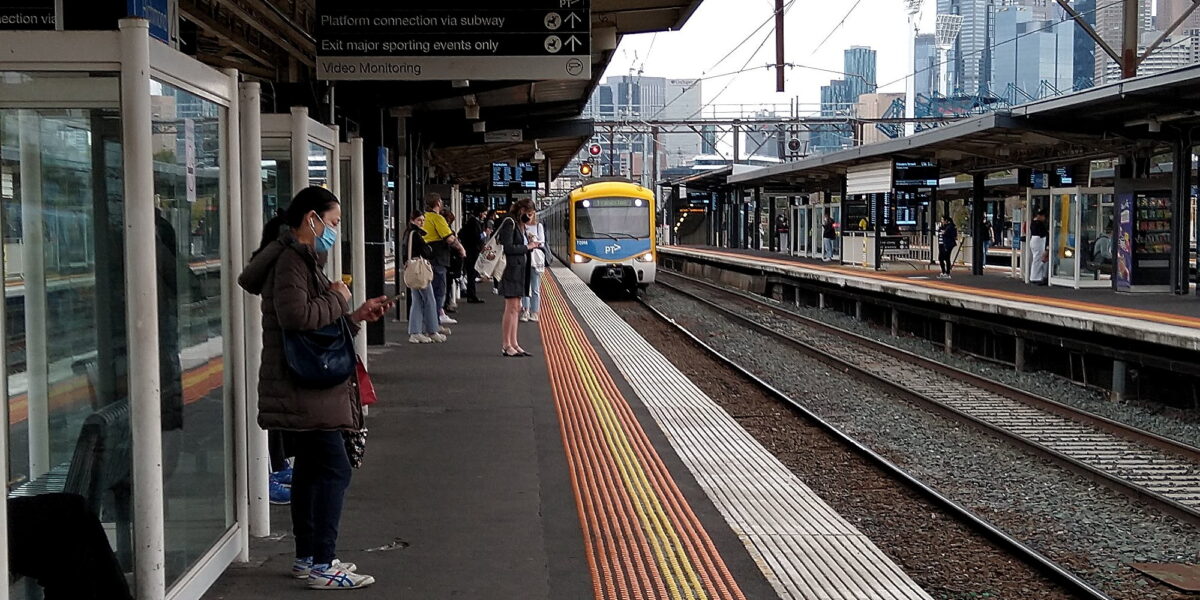There’s a good map doing the rounds showing the sections of the Sydney Trains network that run every 10 minutes on weekdays off-peak.
Bambul has expanded this into a blog post, which also includes another map of 15 minute frequencies.
A couple of people asked if there was a Melbourne version of the 10 minute train map, and since nobody else has done one, I thought I’d have a go.
I’ve gone for a slightly different format. This shows 7-day daytime frequencies: at least every 10 minutes in green, 15 in blue, 20 in yellow, 30-40 in red, less frequent in grey.

If the colour fills are a bit clumsy or the colours themselves too garish, I apologise – one of my pet hates is graphs and diagrams where colours don’t contrast enough for a partially colourblind person like myself to properly tell them apart.
Where different service levels apply on different days, I’ve shown the less frequent level.
Anyway, some things to note here:
Each City Loop tunnel gets a train at least every 10 minutes all day.
Other than that, 10 minute services are mostly found on the lines with combined services, out as far as junction stations: Newport, Clifton Hill, Dandenong.
The exception is Frankston, which has the frequent service to the end of the line. This is not entirely surprising – apart from the politics, on a network where (even off-peak) a lot of travel demand is concentrated on the Central Business District, it’s the longest lines that have the most crowding on the inner section, therefore need more frequent services to manage loads.
Often those in power think only about crowding when they consider frequency, and not at all about minimising waiting times. Even so, some less frequent lines do (or at least did, pre-COVID) get crowding throughout the day.
Some lines such as Sandringham and Glen Waverley have trains every 15 minutes on weekdays, but only every 20 on weekends.
The Geelong line is the only V/Line service that runs at least every 40 minutes in daytime every day – and double that frequency on weekdays.
In keeping with its status of having the most confusing stopping patterns, the Belgrave/Lilydale line is the only one where the weekend service is more frequent than the weekday daytime service. However even that isn’t cut and dried, as some stations get additional express trains on weekday mornings.
Several lines are shown as 20 minutes, but have frequencies as low as 40 minutes until around 10am on Sunday mornings – an appallingly poor service for a city of 5 million people. Equally, evening frequency is very patchy in some cases.
Many Melbourne rail lines are very “peaky” with far more services during traditional commuter peaks than at other times. But I’m interested here in daytime frequency that you can depend on any day of the week.
Good frequency minimises the impact of cancellations. And it means the network can better handle unexpected surges in demand, such as for major events with unpredictable timing – for example a big cricket game suddenly hit by rain.
But most of all, good frequency all day every day means people can get around easily, without long waits, without excessive planning or adjusting their schedule to fit the train timetable.
It also makes connections much easier, meaning the different public transport modes and routes work much more effectively as a network, making them all more useful for people, and a more attractive competitor to driving.
Most of the Metro network could provide higher all-day frequency with zero additional infrastructure, if only government would invest in the extra services.
Last year’s big timetable change brought progress – it would be great to see more.

5 replies on “Train map: frequency”
Wondering whether you may be in the know about if any timetable upgrades are coming this year (aside from what we know RE: Cranboutne). Obviously not expecting details but would think something would be coming given it’s an election year.
What is somewhat telling is, with the exception of the Frankston and Dandenong services, and obviously newer lines, the frequencies haven’t changed much since the 1970s. Glen Waverley, as long as I remember (more than 50 years) has had 15 minute off peak weekday frequencies, Ringwood 15-20, Belgrave 30-40 and so on. The anomaly where the Lilydale and Belgrave lines had better weekend services than weekday also existed. I’ve found an old article in September 1980 Newsrail which confirms most of this. The main difference I guess is “better” Sunday services, although I’m guessing this is still way short of what it should be.
@James – there have been some subsequent frequency improvements though often only piecemeal. Sandringham got its 20 min maximum wait (day and night 7 days except Sunday mornings) in the early 1990s. Under Jeff Kennett interpeak frequencies on lines like Dandenong and Frankston went from 20 to 15 min. Some other improvements eg Alamein. National Express boosted Sunday evening services from 40 to 30 min while they remained 40 min on the (then) Connex half of the network. Also Sunday morning travel is better due to Night Network.
The big cuts I think happened in 1978 where basic Mon-Sat evening frequencies were cut from 20 to 30 minutes on the established core of the network. Only the Frankston and Williamstown lines have had their night service fully restored to 20 min 7 days. There were also cuts in the 1950s when the inner ring including stations like Williamstown and Essendon were much more intensively served than now. Some of this went to fund peak service for further out.
Animation on interpeak train frequencies here: https://www.youtube.com/watch?v=6G5C_rkBG_s
And nights: https://www.youtube.com/watch?v=hOYOMKBnXq4
Plus there are some operators in Sydney who use colour coding to indicate frequency (such as Hillsbus), similar to the map you created for trains in Melbourne.
[…] The key to the empty platforms – Melbourne’s poor off-peak service frequencies, which see most lines only seeing a train every 20 minutes. […]